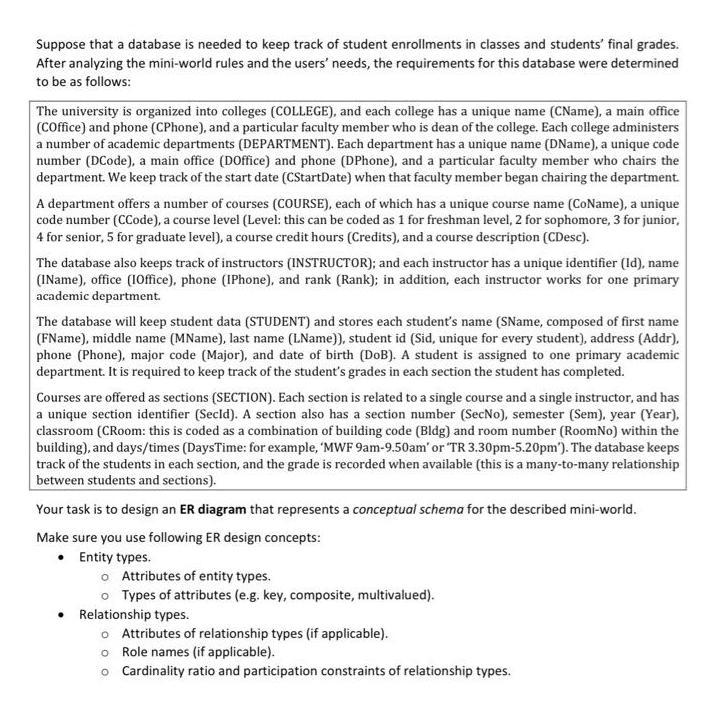Answered step by step
Verified Expert Solution
Question
1 Approved Answer
Suppose that a database is needed to keep track of student enrollments in classes and students' final grades. After analyzing the mini-world rules and

Suppose that a database is needed to keep track of student enrollments in classes and students' final grades. After analyzing the mini-world rules and the users' needs, the requirements for this database were determined to be as follows: The university is organized into colleges (COLLEGE), and each college has a unique name (CName), a main office (COffice) and phone (CPhone), and a particular faculty member who is dean of the college. Each college administers a number of academic departments (DEPARTMENT). Each department has a unique name (DName), a unique code number (DCode), a main office (DOffice) and phone (DPhone), and a particular faculty member who chairs the department. We keep track of the start date (CStartDate) when that faculty member began chairing the department. A department offers a number of courses (COURSE), each of which has a unique course name (CoName), a unique code number (CCode), a course level (Level: this can be coded as 1 for freshman level, 2 for sophomore, 3 for junior, 4 for senior, 5 for graduate level), a course credit hours (Credits), and a course description (CDesc). The database also keeps track of instructors (INSTRUCTOR); and each instructor has a unique identifier (Id), name (IName), office (1Office), phone (IPhone), and rank (Rank); in addition, each instructor works for one primary academic department. The database will keep student data (STUDENT) and stores each student's name (SName, composed of first name (FName), middle name (MName), last name (LName)), student id (Sid, unique for every student), address (Addr), phone (Phone), major code (Major), and date of birth (DOB). A student is assigned to one primary academic department. It is required to keep track of the student's grades in each section the student has completed. Courses are offered as sections (SECTION). Each section is related to a single course and a single instructor, and has a unique section identifier (Secld). A section also has a section number (SecNo), semester (Sem), year (Year), classroom (CRoom: this is coded as a combination of building code (Bldg) and room number (RoomNo) within the building), and days/times (DaysTime: for example, 'MWF 9am-9.50am" or "TR 3.30pm-5.20pm). The database keeps track of the students in each section, and the grade is recorded when available (this is a many-to-many relationship between students and sections). Your task is to design an ER diagram that represents a conceptual schema for the described mini-world. Make sure you use following ER design concepts: Entity types. Attributes of entity types. Types of attributes (e.g. key, composite, multivalued). Relationship types. Attributes of relationship types (if applicable). o Role names (if applicable). Cardinality ratio and participation constraints of relationship types.
Step by Step Solution
There are 3 Steps involved in it
Step: 1

Get Instant Access to Expert-Tailored Solutions
See step-by-step solutions with expert insights and AI powered tools for academic success
Step: 2

Step: 3

Ace Your Homework with AI
Get the answers you need in no time with our AI-driven, step-by-step assistance
Get Started


